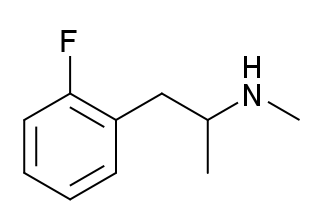2-Fluoromethamphetamine (also known as 2-FMA) is an amphetamine with effects and chemical structure similar to methamphetamine. It’s almost exclusively used as a recreational stimulant and research chemical and is commonly included in a class of substances called designer drugs or legal highs.
Keep reading for an overview of this research chemical containing information on the general makeup, history, dosage, administration, 2-fluoromethamphetamine reviews, and potential side effects of this substance. This information is not intended as a recommendation; rather, it’s intended to provide readers with a comprehensive snapshot of the research chemical.
General Information on 2-Fluoromethamphetamine
2-Fluoromethamphetamine is known as a designer amphetamine that is based on the molecular structure of methamphetamine. It’s known for inducing standard stimulant effects and is often used recreationally as a study aid or motivational enhancement. It is somewhat lesser-known compared to other amphetamines and is unique in that it doesn’t activate serotonin receptors.
2-FMA is often sold in powder or crystal form, but may also appear in online markets in other forms like pellets, capsules, or pills.
There is a strong possibility that 2-FMA will be detected in a blood, urine, skin, or hair analysis depending on the user’s metabolism and frequency of use, especially in panels that test for amphetamines.
History of 2-FMA
There is little documentation on the origin of 2-fluoromethamphetamine, but it is reported to have appeared in online research chemical distribution channels as early as 2007. It’s closely related to other chemicals like 2-FA, 4-FA, 3-FMA, and 4-FMA. It’s considered an analog to methamphetamine, which means it shares a similar molecular structure and creates comparable effects in humans. It’s also often compared to brand-name prescription drugs like Adderall, Dexedrine, and most commonly, Vyvanse.
2-FMA is considered a controlled substance in many countries, including Canada, China, Germany, New Zealand, Switzerland, Turkey, The United Kingdom, and Ukraine. It remains technically legal in the US, though because of its close relation to methamphetamine, it could fall under one of the many umbrella laws enacted by various states. Possession and sale of 2-FMA is also potentially illegal under the Federal Analogue Act, though this act often makes allowances for research chemicals and chemicals that are not labeled for human consumption.
2-fluoromethamphetamine is distributed online as well as offline via individual suppliers. It’s recommended that users research the legality of 2-FMA within their local jurisdiction to ensure that the 2-FMA research chemical is considered a legal drug in their region.
Dosage and Administration
Substance use, even with legal drugs like 2-FMA, should be approached cautiously with an understanding of all risks and benefits involved. Some of the potential negative side effects of 2-FMA can be found at the end of this article.
The effects of 2-FMA can differ based on:
- the dosage amount and frequency
- the user’s health, height, and weight
- the user’s previous experience with the substance
- additional substances used at the same time, including prescription medications
- the method of administration
- the user’s tolerance of this or similar substances
When administering any substance, use a test kit or strips to ensure the legitimacy of the drug and follow harm reduction protocols like sober supervision for the best outcome.
It’s recommended to start with a small dose initially and then increase the dosage as you become more familiar with the effects and the way your body reacts to 2-FMA.
10-20mg per 100 lbs. of body weight is a typical dose for administration via the following methods:
Oral Administration
2-fluoromethamphetamine can be administered orally in capsule or pill form, mixed with a drinking liquid, swallowed in crystal form or ingested by wrapping powder in a layer of tissue or cigarette paper.
Nasal Insufflation
2-FMA can be insufflated nasally or snorted. This method often results in a more rapid onset of effects and is said to induce temporary bouts of uncontrollable tremors and feverish perspiration, but these effects are reported to wear off within a few minutes.
Vaporization
Like other amphetamines, 2-fluoromethamphetamine can be dissolved in a vaporizing liquid and inhaled using a vaporizer or smoked in a pipe. This method carries an increased risk of danger as it alters the chemical makeup of the substance.
Redosing
Some users administer subsequent doses to counteract or prevent the effects from wearing off as a means of prolonging the high from 2-FMA. This substance may induce an intense urge to redose (like other amphetamines) and this side effect should be considered when contemplating additional doses. When redosing, aim to use an equal or lesser amount than the initial dose until you know how the drug reacts in your system.
User 2-FMA Reviews
Research chemical reviews are often self-reported and should be taken anecdotally, not as evidence or fact. The timelines and effects mentioned here are an approximation based on the self-reported experience of other users.
Onset of Effects
Users may expect to begin feeling the effects of 2-fluoromethamphetamine within 30-60 minutes, depending on the dosage and the method of administration. 2-FMA are reported to last between 4-8 hours from the onset. Users typically report a gradual onset, though administering via nasal insufflation may result in a faster onset and a rush-like feeling.
Improved Mood
Many users report a temporarily elevated mood and more pleasant demeanor while under the influence of 2-FMA. This may in turn result in increased sociability and disinhibition. This effect may reverse in high doses, causing users to feel discomfort and agitation instead.
Increased Productivity
One of the main benefits that users consistently report while using 2-fluoromethamphetamine is improved focus and motivation to complete tasks. This is why it’s often compared to Vyvanse, Adderall, and other “study drugs”.
Increased Libido
Many users report experiencing an increase in their sex drive as a result of administering 2-FMA. Users may feel an elevated desire for sexual contact or have an increase in sexual thoughts and feelings following initial and subsequent doses.
Energy Boost
A mild increase in energy and suppressed desire to rest is another common experience when using 2-FMA. Users often report feeling more awake, alert, and invigorated. This may cause difficulty sleeping both during and after the duration of the drug’s effects.
Euphoria
Users report experiencing feelings of euphoria that are more mild compared to other amphetamines, which reduces the likelihood of distractions and difficulty concentration. This effect is only reported in light to moderate doses, as higher doses appear to dramatically increase the euphoric effects and cause difficulty concentrating.
Anticlimax
According to users’ self-reported 2-FMA reviews, the offset of effects is gentle compared to other amphetamines and stimulants in typical doses. Mild irritability, insomnia, drowsiness, and low mood may be experienced as a result of high doses, depending on the user.
Potential Side Effects of 2-FMA
As with any substance, there are potential side effects of 2-FMA. Some of the potential side effects include (but aren’t limited to):
- Fever
- Dizziness
- Excessive itching
- Reduced appetite and potential weight loss
- Teeth grinding and/or jaw clenching
- Sweating
- Agitation and aggression
- Low mood
- Insomnia and irregular sleep patterns
- Hypertension
- Seizures
- Paranoia
- Hallucinations
- Death
If you experience severe negative effects, contact your local emergency department and let them know the dosage and frequency of 2-FMA that you have self-administered to prevent reactions with other drugs they may prescribe to prevent further harm.


